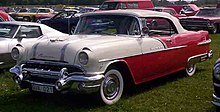Pontiac Laurentian
From the 1950s to the 1970s, GM manufactured its own series of upper-middle-class cars in Canada , which differed from US models such as the Catalina , the Star Chief , the Executive and the Bonneville . In 1959, the Canadian models, which were based on the Chevrolet model lines Biscayne , Bel Air and Impala , were called Strato Chief , Laurentian and Parisienne . When Chevrolet introduced the "Super Sport" in 1962, Pontiac Canada responded with the Custom Sport (renamed 2 + 2 in 1967 , corresponding to a designation in the USA for a specific model of the Catalina). And when Chevrolet brought out the "Impala" / "Caprice" in mid-1965 to compete against Ford's LTD , Pontiac Canada introduced the Grand Parisienne for the 1966 model year .
Like all Canadian Pontiacs built from 1955 to 1970, the Laurentian was based on Chevrolet's large chassis, drive train components and other parts, but had the body of the Pontiac Catalina from the USA. So z. B. a 1964 Laurentian looks like a Catalina from the same year, but technically has more to do with a Chevrolet Bel Air. Until at least 1967, however, the Laurentian wore the three stars that are usually seen on the Pontiac models Star Chief and Executive, even if the other exterior equipment corresponds to that of the Catalina.
The Laurentian was available in the same body styles as the Chevrolet Bel Air until 1962, including hardtop and sedan styles. After 1963, hardtop models were only available in the Parisienne and Grand Parisienne series , which corresponded to the Chevrolet models Impala and Caprice . In 1969, however, there were again 2-door hardtop coupés at the Strato Chief and Laurentian, because Pontiac phased out the 2-door Catalina in the USA after 1968.
Unlike the Parisienne , which was also introduced in the USA in mid-1983, the Laurentian and Strato Chief were never sold there. They were only made for the Canadian market and for export as kit cars .
Some examples were assembled as CKD kits at Holden in Australia or as SKD kits in neighboring New Zealand . The kits were also assembled at GM's plants in the Netherlands and South Africa . Canadian models were used for this purpose, as Canada, as a member of the Commonwealth, had tariff advantages when importing into Australia and South Africa. But above all, there was, firstly, an economic advantage in the supply of two different GM assembly lines from the same parts source; secondly, the Canadian Pontiacs, like the Chevrolets, were more suitable for countries with higher gasoline prices than the USA, and thirdly, the smaller Canadian Pontiacs were without the size and weight of their US counterparts are more suited to adapting to circumstances in countries where space is limited, such as: B. Europe and the countries with left-hand traffic, where oversized cars also have oversized disadvantages.
These right-hand drive cars had the same dashboards as their Chevrolet siblings (Impalas and Bel Airs were also exported to Australia; New Zealand only got the Impalas), so it was enough to design even a right-hand drive dashboard for one vehicle size. So the models 1962-1964 had only one dashboard design, although the designs in Canada changed annually; the 1965–1968 models also all had a converted 1965 Chevrolet dashboard. The right-hand drive cars also had the old, short, counter-rotating windshield wipers, unlike the co-rotating ones on the left-hand drive Canadian versions. Radios, upholstery, and two-stage heaters were sourced from local manufacturers - some Australian cars also had the Frigidaire air conditioners made there.
Web link
source
Gunnell, John: Standard Catalog of American Cars 1946-1975. Krause Publication, Iola (2002), ISBN 0-87349-461-X .


